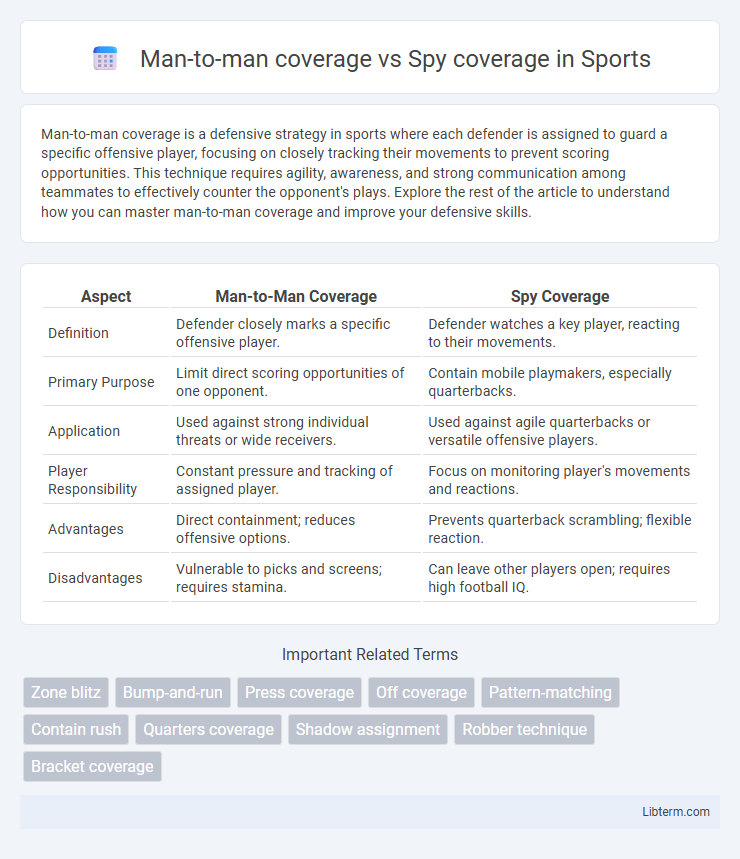Man-to-man coverage is a defensive strategy in sports where each defender is assigned to guard a specific offensive player, focusing on closely tracking their movements to prevent scoring opportunities. This technique requires agility, awareness, and strong communication among teammates to effectively counter the opponent's plays. Explore the rest of the article to understand how you can master man-to-man coverage and improve your defensive skills.
Table of Comparison
| Aspect | Man-to-Man Coverage | Spy Coverage |
|---|---|---|
| Definition | Defender closely marks a specific offensive player. | Defender watches a key player, reacting to their movements. |
| Primary Purpose | Limit direct scoring opportunities of one opponent. | Contain mobile playmakers, especially quarterbacks. |
| Application | Used against strong individual threats or wide receivers. | Used against agile quarterbacks or versatile offensive players. |
| Player Responsibility | Constant pressure and tracking of assigned player. | Focus on monitoring player's movements and reactions. |
| Advantages | Direct containment; reduces offensive options. | Prevents quarterback scrambling; flexible reaction. |
| Disadvantages | Vulnerable to picks and screens; requires stamina. | Can leave other players open; requires high football IQ. |
Introduction to Defensive Football Strategies
Man-to-man coverage assigns each defensive back to closely guard a specific receiver, enhancing direct accountability and reducing passing lanes with precise coverage. Spy coverage employs a designated defender, often a linebacker or safety, tasked with monitoring and reacting to a single offensive player, typically a mobile quarterback, to contain escapes and scrambling. Both strategies are essential in defensive football, balancing individual matchup strengths with adaptive game situations.
Defining Man-to-Man Coverage
Man-to-man coverage is a defensive strategy in football where each defender is assigned to cover a specific offensive player, closely monitoring their movements throughout the play. This technique emphasizes individual responsibility and tight coverage to limit the receiver's opportunities to catch the ball. Unlike zone or spy coverage, man-to-man demands high athleticism and awareness to maintain effectiveness against dynamic offensive schemes.
Understanding Spy Coverage
Spy coverage in football defense involves assigning a single defender, usually a linebacker or safety, to closely monitor a specific offensive player, often the quarterback, to prevent scrambles and unpredictable plays. Unlike traditional man-to-man coverage that matches defenders with receivers, spy coverage focuses on tracking the target's movement rather than sticking to a route or man. This tactic is particularly effective against mobile quarterbacks and dynamic playmakers, helping defenses limit big plays and maintain discipline in pursuit angles.
Key Differences Between Man-to-Man and Spy Coverage
Man-to-man coverage involves each defender being responsible for closely guarding a specific offensive player throughout the game, emphasizing direct matchups and individual accountability. Spy coverage assigns a designated defender, often a linebacker or safety, to monitor a key offensive player, typically the quarterback, to contain their movement and prevent scrambling. The key difference lies in man-to-man covering all offensive players individually, while spy coverage focuses on tracking a single player to neutralize their impact on the play.
Advantages of Man-to-Man Coverage
Man-to-man coverage offers precise defensive assignments by matching defenders to specific offensive players, enhancing accountability and reducing mismatches. This technique enables defenders to closely monitor their assigned opponent's movements, minimizing the effectiveness of targeted passes or routes. Furthermore, man-to-man coverage supports aggressive play, allowing defenders to disrupt plays directly and adapt to offensive strategies effectively.
Benefits of Using Spy Coverage
Spy coverage offers strategic advantages over traditional man-to-man coverage by allowing defenders to monitor a specific offensive player while maintaining overall defensive flexibility. This approach reduces the risk of mismatches and helps contain dynamic playmakers by reacting quickly to their movements without leaving other areas vulnerable. Utilizing spy coverage improves team adaptability and enhances ability to disrupt key offensive strategies effectively.
Situational Effectiveness: When to Use Each Coverage
Man-to-man coverage excels in situations requiring tight, individual defensive assignments against key offensive threats, making it ideal for short-yardage downs and when defending against elite receivers. Spy coverage proves most effective against mobile quarterbacks, as it allows a designated defender to monitor and contain the quarterback's movements, preventing scrambles and extended plays. Teams often select man-to-man in predictable passing situations and deploy spy coverage when facing dual-threat quarterbacks to balance pressure with containment.
Common Challenges and Weaknesses
Man-to-man coverage often struggles with maintaining tight assignments against quick receivers, leading to potential mismatches and blown coverages. Spy coverage can be compromised by a defender's delayed reaction to mobile quarterbacks, resulting in missed opportunities to contain scrambling. Both strategies face challenges in adapting to complex offensive schemes that exploit individual weaknesses and create open passing lanes.
Notable NFL Examples of Each Coverage
In NFL history, man-to-man coverage has been famously exemplified by Richard Sherman's lockdown defense with the Seattle Seahawks, consistently neutralizing top receivers through tight, individualized marking. Spy coverage, which assigns a defender to monitor a single opponent regardless of their position, gained prominence with players like Von Miller spanning from the Denver Broncos, effectively containing mobile quarterbacks such as Russell Wilson. These coverage strategies showcase distinct tactical approaches, with man-to-man focusing on direct contest of receivers and spy coverage emphasizing containment of dynamic, elusive threats.
Choosing the Right Coverage for Your Team
Selecting the right defensive strategy between man-to-man coverage and spy coverage depends on your team's personnel and opponent's offensive tendencies. Man-to-man coverage excels when defenders possess strong individual skills to match up effectively against receivers, while spy coverage is ideal for neutralizing mobile quarterbacks by assigning a dedicated defender to track their movements. Analyzing your team's speed, agility, and football IQ alongside opponent dynamics ensures the chosen coverage maximizes defensive efficiency and limits big plays.
Man-to-man coverage Infographic

 libterm.com
libterm.com